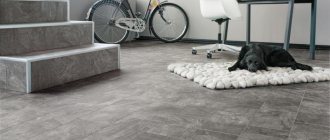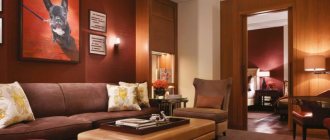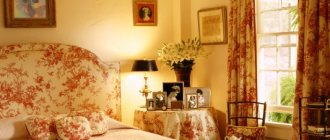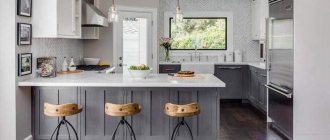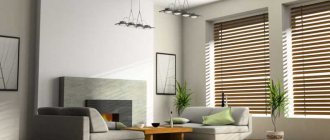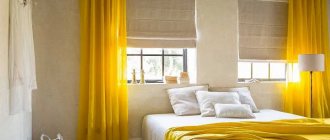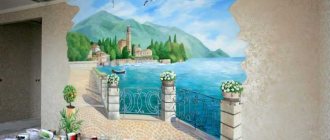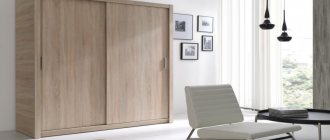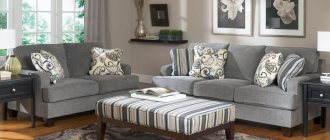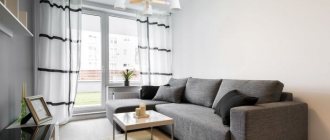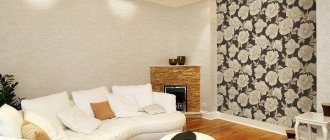Many people consider the use of gray in the interior to be unjustifiably gloomy, faded and uninteresting.
However, this universal shade can look restrained, elegant and stylish, just a competent selection of textures and adjacent tones. How to adequately implement an interior in gray tones?
Monochrome interior of a spacious living room.
Dining room decor.
The influence of gray color on the psyche
One of the common practices for personality research in psychology is the Luscher color test. According to him, gray color is chosen by people exhausted by stress and emotional tension due to life circumstances. This shade represents peace and tranquility - this is what residents of the “concrete jungle” often crave when they return home after a hard day at work. Gray color in the interior will help them relax their tense mind and restore moral strength.
A neutral tone is suitable for people who are tired of the everyday hustle and bustle - those who have direct contact with people, and those who “work with their heads.” A gray color palette in the interior will help you immerse yourself in a kind of prostration, temporarily detaching yourself from external stimuli and difficulties.
What colors go with gray in the interior? Yes, almost everything! Therefore, if you are afraid of the monochrome and “boringness” of the implemented idea, or if you are simply in the mood, it is easy to add a few bright notes in decorations and textiles to such a design - the space will instantly be transformed.
Velvety pearl shades promote relaxation.
Graphite and anthracite shades are very risky.
What shades of blue are there?
A wide variety of shades makes up the rich blue range. Warm colors used in the interior calm and set you in a positive mood. Cool shades invigorate and push you to new achievements.
Among the rich tones included in the dark blue palette are:
- sapphire;
- midnight blue;
- bright ultramarine;
- royal blue;
- cobalt.
- indigo.
Table
Designers advise using shades of blue to create the interior of rooms with windows facing south. On a stuffy hot day, this will help create a feeling of coolness. For the same reason, blue tones are not suitable for rooms that are not on the sunny side.
Also read about turquoise color -
And about the blue color -
Combination with other colors
What does gray color go with in the interior? Being a neutral tone, it easily adapts to almost any “neighbor”.
Combination with beige
Perhaps this is the only combination in which this shade looks somewhat inorganic. The point is the different “temperature” of the shades. However, choosing a suitable color combination is not that difficult. For example, playing with contrast, sand furniture looks fresh against the background of an asphalt-colored finish.
Gray-beige color in the interior of a sophisticated bedroom.
Combination with blue and blue
The combination of gray and blue in the interior evokes thoughts of a palette of heavenly shades - from heavy leaden clouds to light cirrus haze, from a clear azure sky to pre-dawn twilight. This design promotes a relaxed atmosphere, and therefore would look most appropriate in rooms of the appropriate purpose.
Gray-blue color in the interior of the living room.
Asphalt color with blue accents in the living room.
IMPORTANT: the gray-blue color in the interior creates a feeling of coolness, which is comfortable in the summer, but brings discomfort in the winter. If you have a “northern” room, introduce warm shades into the design or completely abandon blue.
Combination with brown
The combination of gray in the interior with brown gives a noble and stylish, but sometimes, if you combine the shades incorrectly, a somewhat inorganic combination. Brown belongs to the warm spectrum, and gray belongs to the cold spectrum, which causes color dissonance. However, a competent color combination will make the interior of any of your rooms the embodiment of grace and style.
Dye
Decorating walls by painting them is very popular. The method has a number of advantages:
- it does not require much experience and knowledge; both a teenager and an elderly person can paint the prepared surface;
- no need to hire specialists, all operations are carried out on our own;
- you can choose the most environmentally friendly, safe for health, compositions - water-based emulsion, acrylic and silicone, latex and eco-paints;
- the consumer is not limited in the choice of colors. You can mix gray color of any saturation, adding the desired undertones;
- painted walls are very easy to renew, make cosmetic repairs to an area damaged by careless movement, the actions of children or pets;
- on a monochromatic background, decor of various types looks great: paintings and photos in frames, mirrors, wall clocks and original sconces, pots with climbing plants and shelves, mosaics and wall paintings;
- At any time, the walls can be repainted again using a different color.
The only negative is that painting requires a perfectly flat plaster surface. Any cracks, chips, bulges and even brush hairs on the painted surface will be very noticeable.
Popular interior styles
The colors of concrete, asphalt and iron are most often used in modern interiors, but classic motifs are not alien to them.
Loft
The industrial style of the urban jungle consists almost entirely of gray concrete blocks, metal structures and chrome ventilation systems. A gray interior in this style will be complemented by wide panoramic windows.
In a loft there is no place without metal and brick.
Industrial concrete finish in grunge style.
High tech
Steel shine, polished plastic, tempered glass and the latest technology – these are the pillars on which high-tech is based and where the gray palette looks as organic as possible.
Graphite high-tech kitchen.
Light walls in a high-tech kitchen.
Classic style
A classic interior in gray tones is rarely implemented, but it does exist. Matte solid colors are suitable for this, both for decoration and for furniture and decorations. A calm and relaxing environment during this implementation is guaranteed to you.
Gray floor in the interior of a classic living room.
Scandinavian style
In the northern concept, it is common to use a light palette of steel shades, which are invariably accompanied by snow-white color and wooden texture - also in light shades. An excellent solution for small rooms where home comfort and a calm atmosphere are needed.
Scandinavian room design.
Cozy Scandinavian bedroom with mountain views.
Provence
Rustic styles are characterized by natural gray tones - faded wood, light stone, limestone, etc. Cold and harsh concrete and steel colors have no place here.
Light shade of the walls in the kitchen-dining room in Provence style.
Bright bedroom in Provence style.
Retro
Retro style is also not alien to the gray palette, but it must be used wisely and only with pastel colors. Gray walls in the interior will become a worthy backdrop for “old-school” furnishings.
Living room with retro shades.
Spacious kitchen in retro style.
Decorative plaster
For the final finishing of the walls, special decorative plaster is used. It smoothes the surface perfectly and does not absorb foreign odors, so it can be used even in the kitchen. The surface is resistant to physical impact and abrasion. In addition, repairing a small section of the wall does not present any difficulties: it is enough to cover up a scratch or chip with the same composition.
The original, patterned and textured surface of Venetian plaster creates a magnificent illusion of natural marble or other gray stone. It is usually used when decorating premises in such interior trends as minimalism, hi-tech, art deco. But, it is quite possible to plaster part of the wall, framing it with chic stucco, or organically combine classic wallpaper and a decorative mixture.
Accessories
The implementation of gray color in the interior involves playing with both shades and texture: stonework, fur throws on furniture, dry bleached wood as an accessory or iron beams under the ceiling
Bright accents
When choosing a combination of bright colors and gray in the interior, do not be afraid of mistakes - any “live” and rich color will enliven the space without dissonating with the basic tone.
But try not to overdo it with color - red, for example, being an extremely active shade, in large quantities can begin to bother and “harm” the eye. Make a choice in favor of burgundy, wine or brick shades if they are expected to significantly predominate in the interior. Panels, vases, floor lamps, textiles and even living plants - everything will be used.
A bright sofa and a standout painting on a gray background.
A couple of “juicy” spots diversify the interior.
Textile
Gray textiles in the interior will soften the brightness of the background colors and add nobility to the atmosphere as a whole. Heavy velvet curtains, silk bed linen or fluffy carpet pile - these little things add up to the comfort and overall emotional background of the entire room.
Bathroom
Mirror and glass surfaces, complemented by nickel or chrome elements, seem to be specially created to give the gray color a special luxury. Conveniently placed in the bathroom, they help turn this room into an example of elegance and impeccable style.
Depending on the desired effect, accents of other colors are also needed here:
- turquoise, wine and purple surfaces will add glamorous chic;
- golden-beige shades will bring cozy “warmth”;
- Snow-white and charcoal-black interior details will provide strict sophistication.
Finishing walls, floors and ceilings
Gray color in the interior is most often used as a base, or background, color.
Walls and wallpaper
The combination of gray walls in the interior with bright accents looks more than organic. Its neutral tones serve as a mediator and link between all decorative elements. Paint or concrete panels create the desired atmosphere of industrial loft, minimalism and grunge styles. For adherents of the classics and French romanticism, halftones are preferred: gray-blue, gray-pink, etc. – they look best in residential areas. It is necessary to make sure that there is sufficient lighting for gray walls in the interior - it makes sense to use dark shades only in rooms with a large area and wide windows.
Another design option is gray wallpaper in the interior. Light gray, with small patterns or stripes - they will serve as a worthy backdrop for furnishings in the room.
Photo of a combination of gray wallpaper in a bedroom interior with plain textiles.
Floor
The gray floor in the interior can echo the chosen style of the interior or be completely original. This option is especially good for the bath and kitchen - it is not so easily soiled. The main thing is that the texture of the floor covering
Gray floor in the kitchen interior.
was as flat as possible for ease of cleaning. It is necessary to remember some properties of gray flooring:
- The lighter the shade, the more spacious the room will seem;
- The depressing impression of an overabundance of massive furniture will be corrected by a light floor;
- By choosing an original shade of gray floor in the interior, you can create a non-trivial, stylish and luxurious design.
Brickwork
Natural brickwork is an easily recognizable element of an industrial loft. To achieve a gray color, brick walls are either painted with the appropriate color, or they are initially made of gray bricks. Usually one accent wall, or even part of it, is decorated in this style, harmoniously combining with white or colored wallpaper, paint, and panels.
If the walls of the house are already plastered, but you really want to create an original interior, ordinary plaster or gypsum mixture and a stencil made of thick plastic “brickwork” come to the rescue. With the help of a trowel and level, a full-fledged illusion of masonry of the required sizes and shapes is created in a couple of days. After drying, the surface is primed and painted. You can also use wallpaper with a suitable pattern.
